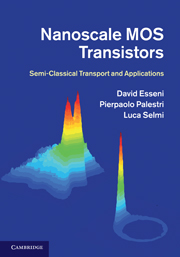Book contents
- Frontmatter
- Contents
- Preface
- Acknowledgements
- Terminology
- 1 Introduction
- 2 Bulk semiconductors and the semi-classical model
- 3 Quantum confined inversion layers
- 4 Carrier scattering in silicon MOS transistors
- 5 The Boltzmann transport equation
- 6 The Monte Carlo method for the Boltzmann transport equation
- 7 Simulation of bulk and SOI silicon MOSFETs
- 8 MOS transistors with arbitrary crystal orientation
- 9 MOS transistors with strained silicon channel
- 10 MOS transistors with alternative materials
- Appendices
- Index
10 - MOS transistors with alternative materials
Published online by Cambridge University Press: 05 August 2011
- Frontmatter
- Contents
- Preface
- Acknowledgements
- Terminology
- 1 Introduction
- 2 Bulk semiconductors and the semi-classical model
- 3 Quantum confined inversion layers
- 4 Carrier scattering in silicon MOS transistors
- 5 The Boltzmann transport equation
- 6 The Monte Carlo method for the Boltzmann transport equation
- 7 Simulation of bulk and SOI silicon MOSFETs
- 8 MOS transistors with arbitrary crystal orientation
- 9 MOS transistors with strained silicon channel
- 10 MOS transistors with alternative materials
- Appendices
- Index
Summary
In the previous chapters we have considered arbitrarily oriented and strained silicon devices with SiO2 gate dielectric. In this chapter we discuss carrier transport in MOS transistors with new materials either in the gate stack or in the device channel.
We first discuss the scattering mechanisms that may be relevant for devices employing high-κ dielectrics in the gate stack, namely remote optical phonons and Coulomb scattering with fixed charges in the gate stack.
Then alternative channel materials such as germanium and gallium arsenide are analyzed using the generalization of the EMA and k·p approaches described in Chapter 8. Gallium-arsenide is also taken as a case study for polar optical phonon scattering, which was not described in Chapter 4.
Alternative gate materials
As discussed in Chapter 1, aggressive scaling of the SiO2 dielectric has led to a substantial increase of the gate leakage current and static power dissipation. To counteract this harmful trend for the performance and reliability of CMOS devices, alternative dielectric materials, the so called high-κ materials with dielectric constant higher than that of SiO2, have been extensively investigated. For optimum flat-band voltage control and improved performance, high-κ dielectrics are often integrated with metal gate materials.
Unfortunately, transistors with high-κ/metal gate stacks often exhibit a lower mobility with respect to the universal curves for thick SiO2 dielectrics. This is illustrated in Fig.10.1, which collects experimental mobility curves for devices featuring HfO2 and HfSiON based gate stacks.
- Type
- Chapter
- Information
- Nanoscale MOS TransistorsSemi-Classical Transport and Applications, pp. 406 - 450Publisher: Cambridge University PressPrint publication year: 2011



